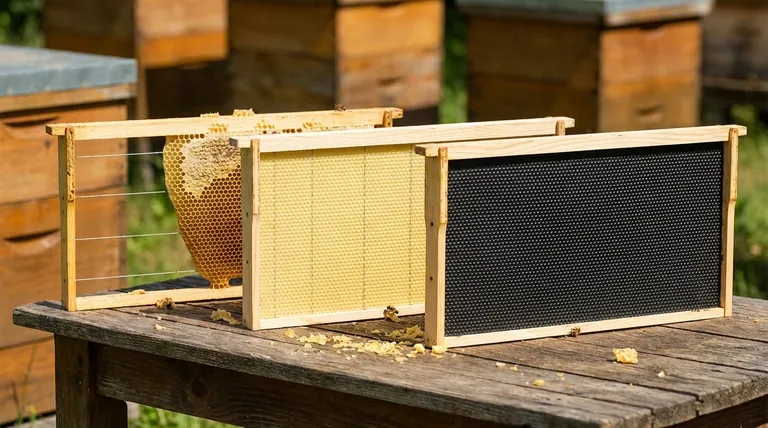Ultimately, comb drawn on wired frames is structurally very different from comb built on plastic or wax foundation, even though bees will draw out the comb to fill the frame in all three cases. The key difference lies in the guidance and support provided to the bees, which directly impacts the comb’s strength, cell uniformity, and the beekeeper’s management practices.
The choice between wired frames, plastic foundation, and wax foundation is a fundamental trade-off. You are balancing the natural, bee-directed comb construction of wired frames against the durability, speed, and uniformity offered by plastic and wax foundations.

The Purpose of Foundation
Foundation serves as a guide for the bees. By providing a base with a pre-stamped hexagonal pattern, beekeepers encourage bees to build straight, even combs that are easy to inspect and manage.
A Baseline for Comparison
Without any foundation or guide, bees will build "wild" or "free" comb, which often curves, connects to other combs (cross-combing), and makes frame removal nearly impossible without destroying the comb. All three systems—wired, wax, and plastic—are designed to prevent this.
Analyzing the Three Core Options
Each method provides a different starting point for the bees, leading to distinct outcomes in the final drawn comb.
Wired Frames (Foundationless)
In this method, horizontal wires are run across an empty frame. These wires provide structural support for the comb the bees build entirely on their own, but they offer no cell pattern guide.
Bees build comb with their own naturally determined cell sizes. This can be beneficial for brood health, as it allows the colony to create drone cells or worker cells as it sees fit.
However, newly drawn foundationless comb is extremely fragile. It can easily break apart in a honey extractor, especially during the first year of use.
Wax Foundation
This consists of a thin sheet of beeswax imprinted with a uniform worker-cell pattern. It is typically embedded with vertical wires for added strength and then installed into a frame.
Bees readily accept wax foundation because it is a familiar material. It provides a strong guide, resulting in very uniform worker brood comb, which is ideal for queen-laying and maximizing the honey-gathering workforce.
The primary drawback is that commercial wax can potentially accumulate pesticides or other contaminants over time. The sheets can also be brittle in cold weather and may warp in extreme heat during storage.
Plastic Foundation
This is a rigid sheet of plastic molded with the hexagonal cell pattern, almost always coated with a thin layer of beeswax to encourage bees to use it.
Plastic foundation is exceptionally durable. It will not sag or warp, and it withstands the high-speed forces of honey extraction without breaking. This makes it a favorite for large-scale honey producers.
The main challenge is bee acceptance. If the wax coating is too thin or has an off-smell, bees may be reluctant to draw it out, sometimes leaving gaps or building burr comb away from the plastic surface.
Understanding the Trade-offs
Choosing the right system requires understanding the direct consequences for your hive and your workflow.
Durability During Extraction
This is the most significant differentiator. Plastic foundation is the clear winner in durability, withstanding extraction and handling with ease.
Well-wired wax foundation is also quite strong once fully drawn. Foundationless wired comb is the most fragile and requires careful handling or is best left as brood comb or cut out for cut-comb honey.
Bee Acceptance and Build Speed
Bees typically accept and build on wax foundation fastest. It's their natural material, and they take to it quickly.
Foundationless comb speed depends entirely on the nectar flow; a strong flow encourages rapid building. Plastic foundation can be the slowest if the wax coating is insufficient.
Cell Size Control
Wired foundationless frames give all control to the bees. They will build the mix of worker and larger drone cells they feel the colony needs.
Both wax and plastic foundation strongly guide the bees to build uniform worker-sized cells, limiting the amount of drone brood the queen can lay on those frames.
Making the Right Choice for Your Goal
Your beekeeping philosophy and primary objectives should guide your decision.
- If your primary focus is natural beekeeping or brood rearing: Wired foundationless frames allow the colony to regulate its own cell size and brood composition.
- If your primary focus is maximum honey production and durability: Plastic foundation's strength during extraction and its long-term reusability make it the most efficient choice.
- If your primary focus is a reliable, traditional, and balanced approach: Wax foundation provides a natural material that bees readily accept, ensuring straight combs ideal for both brood and honey.
Ultimately, the best choice is the one that aligns with your specific management style and goals for your hives.
Summary Table:
| Feature | Wired Frames (Foundationless) | Wax Foundation | Plastic Foundation |
|---|---|---|---|
| Comb Strength | Fragile (risks breaking in extractor) | Strong (when well-wired) | Exceptionally Durable |
| Bee Acceptance | Good (builds naturally) | Excellent (natural material) | Variable (depends on wax coating) |
| Cell Size Control | Bee-determined (mix of worker/drone) | Uniform worker cells | Uniform worker cells |
| Best For | Natural beekeeping, brood rearing | Traditional, balanced approach | Maximum honey production, durability |
Ready to Equip Your Apiary with the Right Foundation?
Choosing the correct foundation is critical for hive health and honey yield. As a leading wholesale supplier to commercial apiaries and distributors, HONESTBEE provides high-quality beekeeping supplies tailored for large-scale operations.
We help you maximize efficiency and durability with:
- Robust Plastic Foundation: Built to withstand repeated extraction cycles.
- Reliable Wax Foundation: For excellent bee acceptance and straight comb.
- Durable Wired Frames: Supporting your foundationless or natural beekeeping methods.
Let's discuss the best foundation solution for your commercial goals. Contact our expert team today for wholesale pricing and personalized support.
Visual Guide

Related Products
- Food Grade Plastic bee Foundation for Bee Frames
- Manual Beeswax Comb Foundation Machine Wax Foundation Mill Embossing Machine
- Notebook Style Beeswax Foundation Mould Wax Foundation Mold
- Colorful Silicone Beeswax Foundation Mold Mould for Beekeeping
- Beeswax Foundation Sheets Beehive Foundation for Wholesale
People Also Ask
- What factors should beekeepers consider when choosing between beeswax and plastic foundation? A Guide to Durability vs. Natural Philosophy
- How to get bees to use plastic foundation? Master the Wax Coating and Resource Strategy
- What is a plastic foundation sheet? A Durable, Reusable Hive Management Solution
- What additional step can improve the performance of plastic foundation in the hive? Apply a Generous Coat of Beeswax
- How does plastic foundation differ from beeswax foundation? Choose the Best for Your Hive's Success
















